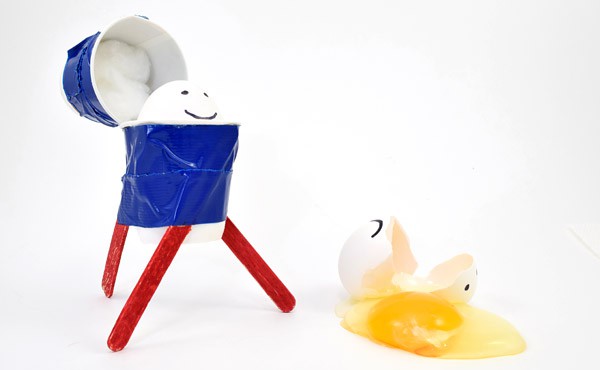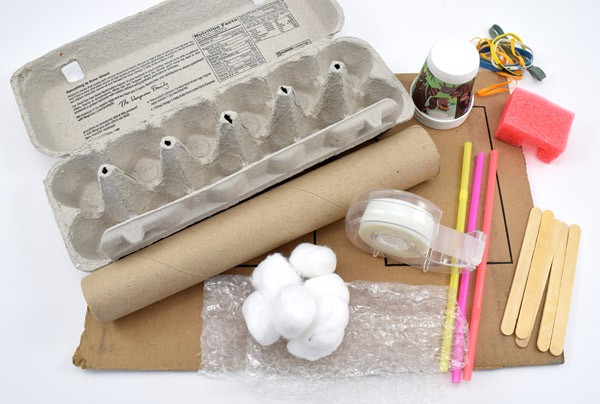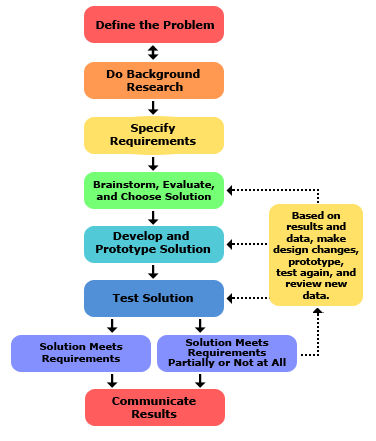Summary

Overview
The egg drop project is a time-honored tradition in many science classrooms. Students build a device to protect an egg and prevent it from breaking when dropped. This project typically relates to lessons about Newton's laws of motion or potential and kinetic energy. However, it is also a great way for students to practice the engineering design process, and learn about the importance of design iteration and learning from failure.
Learning Objectives
- Do background research, brainstorm, and prototype an egg drop design
- Iteratively test and improve the design
- Communicate information about the design process
NGSS Alignment
This lesson helps students prepare for these Next Generation Science Standards Performance Expectations:- MS-ETS1-2. Evaluate competing design solutions using a systematic process to determine how well they meet the criteria and constraints of the problem.
- MS-ETS1-4. Develop a model to generate data for iterative testing and modification of a proposed object, tool, or process such that an optimal design can be achieved.
|
Science & Engineering Practices
Engaging in Argument from Evidence.
Evaluate competing design solutions based on jointly developed and agreed-upon design criteria.
|
Disciplinary Core Ideas
ETS1.B: Developing Possible Solutions.
A solution needs to be tested, and then modified on the basis of the test results, in order to improve it.
|
Crosscutting Concepts
Structure and Function.
Structures can be designed to serve particular functions by taking into account properties of different materials, and how materials can be shaped and used.
|
Materials
 Image Credit: Ben Finio, Science Buddies / Science Buddies
Image Credit: Ben Finio, Science Buddies / Science Buddies
- Assorted craft, packing, and recyclable materials: cardboard, egg cartons, cotton balls, straws, pipe cleaners, wooden skewers, rubber bands, etc.
- Optional: materials to make parachutes (e.g. plastic bag and strings). You can decide whether or not parachutes are allowed.
- Raw eggs
- Recommended: "dummy" eggs for testing, like plastic Easter eggs, hard-boiled eggs, or chocolate candy eggs. These will help reduce the mess and necessary cleanup as students test their designs.
- High location to drop eggs from (bleachers, playground equipment, etc.)
- Paper towels for cleanup
Background Information for Teachers
This section contains a quick review for teachers of the science and concepts covered in this lesson.This lesson is designed to guide your students through the engineering design process (Figure 1) using a classic hands-on activity: an egg drop. You can read about the engineering design process, or assign your students to read about it, in much more detail in this project guide. You can also read about the differences between the engineering design process and the scientific method.
 Image Credit: created by Amy Cowen for Science Buddies / Science Buddies
Image Credit: created by Amy Cowen for Science Buddies / Science BuddiesA flow chart shows the engineering design process. The process begins by defining a problem and completing background research on the problem. Requirements are specified and a solution is chosen. A prototype of the solution is built and tested. If the prototype / solution meets the requirements then the results can be shared. If the solution does not meet all the requirements then another solution is developed and tested. Each iteration uses data from previous tests to meet all of the initial requirements.
Figure 1. Steps of the engineering design process.
Your students will use readily available materials to build a device that can protect an egg during a fall. Egg drop contests frequently reward students whose eggs survive drops from the highest height. Students might only get one chance—if your egg breaks, you are done. This version of the project is intended to emphasize the iterative nature of the engineering design process. Students will be allowed to test their designs before they try them with a real egg. This will give them a chance to identify flaws and improve their designs.
Optionally, this project can be linked to several other physics topics:
- Energy/Energy Conversion/Conservation of Energy: when you raise the egg drop device off the ground, it gains gravitational potential energy (usually just called "potential energy" for short, when "gravitational" is implied by the context). When you drop your device, it falls and gains speed. The potential energy converts to kinetic energy, but the total amount of energy is conserved. When the device hits the ground, all that energy needs to go somewhere. It can be "absorbed" by the device and converted into elastic potential energy (e.g. stretching a rubber band), it can be converted into heat or sound, or it can go into breaking molecular bonds in the materials of your device (or the egg, which is what you want to avoid!). You want to design a device that can safely absorb/dissipate all the kinetic energy on impact without breaking the egg.
- Newton's laws of motion: when your device hits the ground, it experiences a very large change in velocity in a very short period of time. This means it has a very large acceleration (acceleration = change in velocity / change in time). According to Newton's second law of motion, Force = mass × acceleration (F=ma), so if there is a very large acceleration, there must be a very large force. If you can decrease the egg's acceleration (e.g. by adding a parachute so its velocity is not as high to begin with, or adding cushioning so it does not come to a stop as quickly), you will decrease the force on the egg, making it less likely to break. You can also think in terms of Newton's third law of motion: for every reaction, there is an equal and opposite reaction. When the egg hits the ground, it pushes on the ground—but the ground also pushes back up on the egg.
- Pressure: pressure is force per unit area. If you apply the same force over a larger area, the force is more "spread out," and the pressure will decrease. Imagine standing tiptoe vs. standing flat on your feet. The total force (your weight) is the same in each case, but when you stand on your toes, the contact area with the ground is much smaller, so the pressure is higher. Now think about the same concept with an egg. Are you more likely to break through an egg shell if you press down on it with the entire palm of your hand, or if you press with the same force using a needle? In the latter case, the same force is concentrated on a very small area (the tip of the needle), which is more likely to break the egg. Students can use this knowledge to design a device that evenly distributes the impact force across the surface of the egg, making it less likely to crack.




